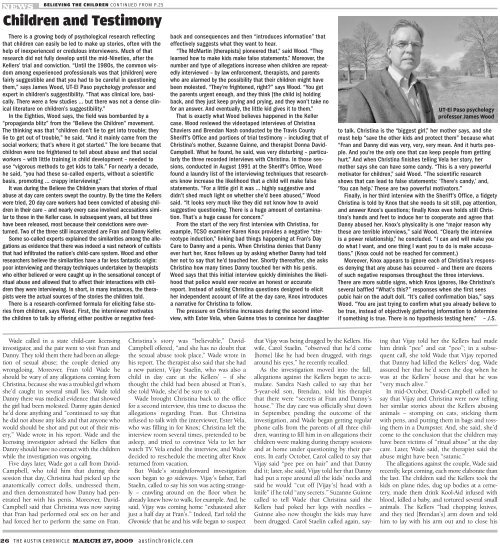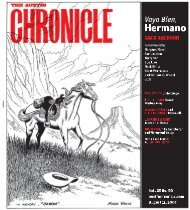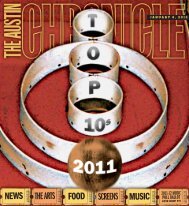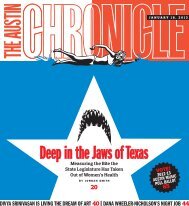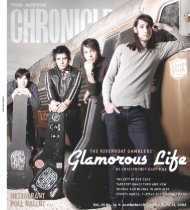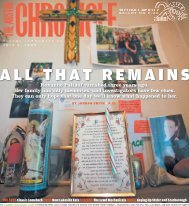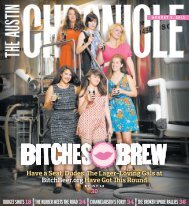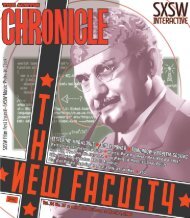March 27, 2009 - The Austin Chronicle
March 27, 2009 - The Austin Chronicle
March 27, 2009 - The Austin Chronicle
You also want an ePaper? Increase the reach of your titles
YUMPU automatically turns print PDFs into web optimized ePapers that Google loves.
Wade called in a state child-care licensinginvestigator, and the pair went to visit Fran andDanny. <strong>The</strong>y told them there had been an allegationof sexual abuse; the couple denied anywrongdoing. Moreover, Fran told Wade heshould be wary of any allegations coming fromChristina, because she was a troubled girl whomshe’d caught in several small lies. Wade toldDanny there was medical evidence that showedthe girl had been molested. Danny again deniedhe’d done anything and “continued to say thathe did not abuse any kids and that anyone whowould should be shot and put out of their misery,”Wade wrote in his report. Wade and thelicensing investigator advised the Kellers thatDanny should have no contact with the childrenwhile the investigation was ongoing.Five days later, Wade got a call from David-Campbell, who told him that during theirsession that day, Christina had picked up theanatomically correct dolls, undressed them,and then demonstrated how Danny had penetratedher with his penis. Moreover, David-Campbell said that Christina was now sayingthat Fran had performed oral sex on her andhad forced her to perform the same on Fran.NEWS BELIEVING THE CHILDREN CONTINUED FROM P.25 ing that Vijay told her the Kellers had madeChildren and Testimony<strong>The</strong>re is a growing body of psychological research reflectingthat children can easily be led to make up stories, often with thehelp of inexperienced or credulous interviewers. Much of thatresearch did not fully develop until the mid-Nineties, after theKellers’ trial and conviction. “Until the 1980s, the common wisdomamong experienced professionals was that [children] werefairly suggestible and that you had to be careful in questioningthem,” says James Wood, UT-El Paso psychology professor andexpert in children’s suggestibility. “That was clinical lore, basically.<strong>The</strong>re were a few studies … but there was not a dense clinicalliterature on children’s suggestibility.”In the Eighties, Wood says, the field was bombarded by a“propaganda blitz” from the “Believe the Children” movement.<strong>The</strong> thinking was that “children don’t lie to get into trouble; theylie to get out of trouble,” he said. “And it mainly came from thesocial workers; that’s where it got started.” <strong>The</strong> lore became thatchildren were too frightened to tell about abuse and that socialworkers – with little training in child development – needed touse “vigorous methods to get kids to talk.” For nearly a decade,he said, “you had these so-called experts, without a scientificbasis, promoting … crappy interviewing.”It was during the Believe the Children years that stories of ritualabuse at day care centers swept the country. By the time the Kellerswere tried, 20 day care workers had been convicted of abusing childrenin their care – and nearly every case involved accusations similarto those in the Keller case. In subsequent years, all but threehave been released, most because their convictions were overturned.Two of the three still incarcerated are Fran and Danny Keller.Some so-called experts explained the similarities among the allegationsas evidence that there was indeed a vast network of cultiststhat had infiltrated the nation’s child-care system. Wood and otherresearchers believe the similarities have a far less fantastic origin:poor interviewing and therapy techniques undertaken by therapistswho either believed or were caught up in the sensational concept ofritual abuse and allowed that to affect their interactions with childrenthey were interviewing. In short, in many instances, the therapistswere the actual sources of the stories the children told.<strong>The</strong>re is a research-confirmed formula for eliciting false storiesfrom children, says Wood. First, the interviewer motivatesthe children to talk by offering either positive or negative feedbackand consequences and then “introduces information” thateffectively suggests what they want to hear.“<strong>The</strong> McMartin [therapists] pioneered that,” said Wood. “<strong>The</strong>ylearned how to make kids make false statements.” Moreover, thenumber and type of allegations increase when children are repeatedlyinterviewed – by law enforcement, therapists, and parentswho are alarmed by the possibility that their children might havebeen molested. “<strong>The</strong>y’re frightened, right?” says Wood. “You getthe parents urgent enough, and they think [the child is] holdingback, and they just keep prying and prying, and they won’t take nofor an answer. And eventually, the little kid gives it to them.”That is exactly what Wood believes happened in the Kellercase. Wood reviewed the videotaped interviews of ChristinaChav iers and Brendan Nash conducted by the Travis CountySheriff’s Office and portions of trial testimony – including that ofChristina’s mother, Suzanne Guinne, and therapist Donna David-Campbell. What he found, he said, was very disturbing – particularlythe three recorded interviews with Christina. In those sessions,conducted in August 1991 at the Sheriff’s Office, Woodfound a laundry list of the interviewing techniques that researchersknow increase the likelihood that a child will make falsestatements. “For a little girl it was … highly suggestive anddidn’t shed much light on whether she’d been abused,” Woodsaid. “It looks very much like they did not know how to avoidsuggestive questioning. <strong>The</strong>re is a huge amount of contamination.That’s a huge cause for concern.”From the start of the very first interview with Christina, forexample, TCSO examiner Karen Knox provides a negative “stereotypeinduction,” linking bad things happening at Fran’s DayCare to Danny and a penis. When Christina denies that Dannyever hurt her, Knox follows up by asking whether Danny had toldher not to say that he’d touched her. Shortly thereafter, she asksChristina how many times Danny touched her with his penis.Wood says that this initial interview quickly diminishes the likelihoodthat police would ever receive an honest or accuratereport. Instead of asking Christina questions designed to elicither independent account of life at the day care, Knox introducesa narrative for Christina to follow.<strong>The</strong> pressure on Christina increases during the second interview,with Ester Vela, when Guinne tries to convince her daughterUT-El Paso psychologyprofessor James Woodto talk. Christina is the “biggest girl,” her mother says, and shemust help “save the other kids and protect them” because what“Fran and Danny did was very, very, very mean. And it hurts people.And you’re the only one that can keep people from gettinghurt.” And when Christina finishes telling Vela her story, hermother says she can have some candy. “This is a very powerfulmotivator for children,” said Wood. “<strong>The</strong> scientific researchshows that can lead to false statements: ‘<strong>The</strong>re’s candy,’ and,‘You can help.’ <strong>The</strong>se are two powerful motivators.”Finally, in her third interview with the Sheriff’s Office, a fidgetyChristina is told by Knox that she needs to sit still, pay attention,and answer Knox’s questions; finally Knox even holds still Christina’shands and feet to induce her to cooperate and agree thatDanny abused her. Knox’s physicality is one “major reason whythese are terrible interviews,” said Wood. “Clearly the interviewis a power relationship,” he concluded. “I can and will make youdo what I want, and one thing I want you to do is make accusations.”(Knox could not be reached for comment.)Moreover, Knox appears to ignore each of Christina’s responsesdenying that any abuse has occurred – and there are dozensof such negative responses throughout the three interviews.<strong>The</strong>re are more subtle signs, which Knox ignores, like Christina’sseveral baffled “What’s this?” responses when she first seespubic hair on the adult doll. “It’s called confirmation bias,” saysWood. “You are just trying to confirm what you already believe tobe true, instead of objectively gathering information to determineif something is true. <strong>The</strong>re is no hypothesis testing here.” – J.S.Christina’s story was “believable,” David-Campbell offered, “and she has no doubt thatthe sexual abuse took place,” Wade wrote inhis report. <strong>The</strong> therapist also said that she hada new patient, Vijay Staelin, who was also achild in day care at the Kellers’ – if shethought the child had been abused at Fran’s,she told Wade, she’d be sure to call.Wade brought Christina back to the officefor a second interview, this time to discuss theallegations regarding Fran. But Christinarefused to talk with the interviewer, Ester Vela,who was filling in for Knox; Christina left theinterview room several times, pretended to beasleep, and tried to convince Vela to let herwatch TV. Vela ended the interview, and Wadedecided to reschedule the meeting after Knoxreturned from vacation.But Wade’s straightforward investigationsoon began to go sideways. Vijay’s father, EarlStaelin, called to say his son was acting strangely– crawling around on the floor when healready knew how to walk, for example. And, hesaid, Vijay was coming home “exhausted afterjust a half day at Fran’s.” Indeed, Earl told the<strong>Chronicle</strong> that he and his wife began to suspectthat Vijay was being drugged by the Kellers. Hiswife, Carol Staelin, “observed that he’d come[home] like he had been drugged, with ringsaround his eyes,” he recently recalled.As the investigation moved into the fall,allegations against the Kellers began to accumulate.Sandra Nash called to say that her5-year-old son, Brendan, told his therapistthat there were “secrets at Fran and Danny’shouse.” <strong>The</strong> day care was officially shut downin September, pending the outcome of theinvestigation, and Wade began getting regularphone calls from the parents of all three children,wanting to fill him in on allegations theirchildren were making during therapy sessionsand at home under questioning by their parents.In early October, Carol called to say thatVijay said “pee pee on hair” and that Dannydid it; later, she said, Vijay told her that Dannyhad put a rope around all the kids’ necks andsaid he would “cut off [Vijay’s] head with aknife” if he told “any secrets.” Suzanne Guinnecalled to tell Wade that Christina said theKellers had poked her legs with needles –Guinne also now thought the kids may havebeen drugged. Carol Staelin called again, say-him drink “pee” and eat “poo”; in a subsequentcall, she told Wade that Vijay reportedthat Danny had killed the Kellers’ dog. Wadeassured her that he’d seen the dog when hewas at the Kellers’ house and that he was“very much alive.”In mid-October, David-Campbell called tosay that Vijay and Christina were now tellingher similar stories about the Kellers abusinganimals – stomping on cats, sticking themwith pens, and putting them in bags and tossingthem in a Dumpster. And, she said, she’dcome to the conclusion that the children mayhave been victims of “ritual abuse” at the daycare. Later, Wade said, the therapist said theabuse might have been “satanic.”<strong>The</strong> allegations against the couple, Wade saidrecently, kept coming, each more elaborate thanthe last. <strong>The</strong> children said the Kellers took thekids on plane rides, dug up bodies at a cemetery,made them drink Kool-Aid infused withblood, killed a baby, and tortured several smallanimals. <strong>The</strong> Kellers “had chopping knives,and they tied [Brendan’s] arm down and toldhim to lay with his arm out and to close his26 T H E A U S T I N C H R O N I C L E MARCH <strong>27</strong>, <strong>2009</strong> a u s t i n c h r o n i c l e . c o m


